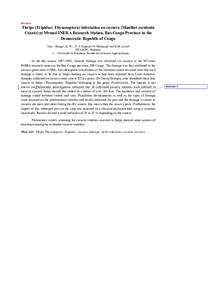| dc.contributor.author | Tata-Hangy, K.W. |
| dc.contributor.author | Mfuti, K. |
| dc.contributor.author | Tuwizana, M. |
| dc.contributor.author | Mahungu, N.M. |
| dc.contributor.author | Lema, K.M. |
| dc.date.accessioned | 2019-12-04T11:07:58Z |
| dc.date.available | 2019-12-04T11:07:58Z |
| dc.date.issued | 2012-02 |
| dc.identifier.citation | Tata-Hangy K.W., Mfuti, K., Tuwizana, M., Mahungu, N. & Lema, K.M. (2012). Thrips (Tripidae; Thysanoptera) infestation on cassava (Manihot esculenta Crantz) at Mvuazi INERA Research Station, Bas-Congo Province in the Democratic Republic of Congo. In: Proceedings of the 11th triennial Symposium of the International Association of Hydrological Sciences held at Memling Hotel: Tropical roots and tuber crops and the challenges of globalization and climate changes, (pp. 406-410), Kinshasa, 4-8 October, Ibadan: ISTRC-AB. |
| dc.identifier.uri | https://hdl.handle.net/20.500.12478/1669 |
| dc.description.abstract | In the dry season 1997-1998, unusual damage was observed on cassava at M'vuazi INERA research station (Lat. 5°25'S, Long. 14°54'E, Alt. 465m asl) in the Bas-Congo province, DR Congo (DRC). The damage was first attributed to cassava green
mite (CGM), but subsequent observations and literature search revealed later that such damage is likely to be due to thrips feeding on cassava. Thrips on cassava had been reported from Latin America. Samples collected on cassava in DRC were sent to IITA curator, who identified these tiny insects as thrips (Thysanoptera; Tripidae) belonging to the genus Frankliniella. The species is not known yet. Preliminary investigations consisted in learning about the field characteristics of the pest and to understand the conditions that lead to high infestations. They indicated that all cultivated cassava varieties were infested in most of cassava farms around the station in a radius of over 50 Km. The incidence and severity of damage varied between variety and sites. Population developments as well as the types of damage were monthly assessed on the predominant varieties and results indicated the pest and its damage to cassava are most prevalent during the dry season, like most other cassava pests. Furthermore, the impact of this arthropod pest on the crop was assessed in a classical exclusion trial using a systemic insecticide CONFIDOR 050 EC. The results showed a yield reduction of 10 to 64.8% depending on the variety. These preliminary results revealed that thrips could be a potential threat to cassava production and attention needs to be given to its control methods. |
| dc.description.sponsorship | United States Agency for International Development |
| dc.format.extent | 406-410 |
| dc.language.iso | en |
| dc.publisher | International Association of Hydrological Sciences |
| dc.subject | Cassava |
| dc.subject | Thrips |
| dc.subject | Plant Pests |
| dc.subject | Pests |
| dc.subject | Democratic Republic Of Congo |
| dc.subject | Thysanoptera |
| dc.subject | Tripidae |
| dc.subject | Dry Season |
| dc.subject | Cassava Green Mite |
| dc.title | Thrips (Tripidae; Thysanoptera) infestation on cassava (Manihot esculenta Crantz) at Mvuazi INERA research station, Bas-Congo Province in the Democratic Republic of Congo |
| dc.type | Conference Proceedings |
| cg.contributor.crp | Roots, Tubers and Bananas |
| cg.contributor.affiliation | International Institute of Tropical Agriculture |
| cg.contributor.affiliation | Institut National pour l'Etude et la Recherche Agronomiques, Democratic Republic of Congo |
| cg.contributor.affiliation | Université de Kinshasa |
| cg.coverage.region | Africa |
| cg.coverage.region | Central Africa |
| cg.coverage.country | Congo, Dr |
| cg.authorship.types | CGIAR and developing country institute |
| cg.iitasubject | Cassava |
| cg.iitasubject | Pests Of Plants |
| cg.howpublished | Formally Published |
| cg.publicationplace | Ibadan, Nigeria |
| cg.accessibilitystatus | Limited Access |
| local.dspaceid | 82831 |
| cg.targetaudience | Scientists |


